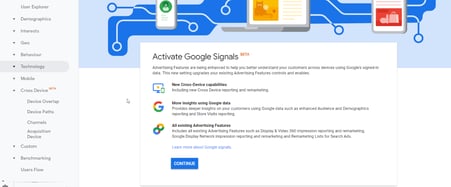What is it?
First announced in July 2018, Google signals is the name given to the Google product that enables cross-device reporting and remarketing. From analytics point of view, tracking a user (a real human) targeting remarketing across multiple browsers or devices is a complex story. Google is supplying a solution for this with Signals, where it utilises it's own data of user's that are signed in with a Google-account.
So for example, if a person logs in to their Google-account on Chrome-browser within their phone, tablet or computer at work or at home, they will be identified and recognized as one person, across all devices. So, a perfect solution to tackle the multiple devices per user problem.
Google Signals also has a significant role in user-specific and cross-device identification and tracking in the new Google Analytics version (GA4).
Note: it only works for logged-in Google users, so there is a bias there, as those users might behave a certain way at the website that differs from the average user.

Google Signals logo
What are the benefits of using Google Signals?
Google Signals is an almost perfect solution for tracking a user across multiple devices. For example if you have an online store, Google Signals can help you get unique information from different stages of the Buyers Journey when the user is changing from a device to another. Without identifying and recognizing the user in different devices, there is no way to know if the purchase process was cut off or if it continued on another device.
These are the main benefits when Google Signals is activated:
- Remarketing – this extends any eligible remarketing activities to work cross-device
- Ads reporting – you’ll get more information about users
- Demographics and interest reports – more information will be collected
- Cross-device reports (in beta) – you will start to see cross-device information in your account
Let's take an example: a user starts the purchasing process by mobile by searching for a product through a search engine and ends up to an online store. Then the user adds the product to the basket, but continues the process later with a different device – by laptop.
Without identification across different devices, this one user is reported as two different visitors; one mobile visitor from organic search (in the best case with a search term), that didn't convert and another desktop visitor from direct traffic, that goes straight to the product and converts. When looking at these two visitors, they act in complete opposite ways. The other is only considering buying the product and the other has already made the purchasing decision.
If the online store is using remarketing, this one user ends up seeing two kinds of ads, because they are added to both, the converted audience and the audience that dropped off their purchasing process. Whereas when using Google Signals the user is considred as a single converted user.
Also in the world of GA4, using Google Signals gives better tools in tracking down multiple-device users. Please note though, that if there's a lot of multiple-device users in a specific service, this will decrease user counts in every GA4 report.
When should you not use Google Signals?
There are af ew cases when using Google Signals is not worth using. Even though the setup itself is very simple, you will need to update your site's privacy policy, which requires a bit more work. Because of this, if Google Signals does not bring you a lot of benefit, you shouldn't use it. This might be the situation for example in the following cases:
- Your visitors are mainly using only one device: Google Signals reports on user's paths between multiple different devices, but if users only have one device, these paths don't exist.
- Your site has very little users in general: users signed in to a Google-account are only a part of all of the visitors, so if your site has only a few users in total, Google Signals won't give a lot of data.
- You don't do remarketing: Google Signals shows data only from users that have enabled Ads Personalization in their Google-account. The value that it adds is particularly in enriching ads and marketing data. If you don't do remarketing, the data that Google Signals gives, might not be useful for you.
How should Google Signals be setup?
So first it needs to be activated on the Google Analytics Property level. There’s no need to update your website code or analytics script, so you don't need to get more help from a developer. There are more details online: for GA4 here: https://support.google.com/analytics/answer/9445345 and for GA Universal Analytics here: https://support.google.com/analytics/answer/7532985.

When you activate Google Signals, existing Google Analytics features are upgraded to include more information from Google users, but only for those who have turned on Ads Personalization.
To be clear, data will be incomplete. That’s the definition of how it has been setup: it only concerns visitors that have Google authentication activated on their browsers. On top of that, they will have had to turn on Ads Personalization. On that sense it’s comparable to the demographics and interests features as it only concerns a part of the total audience and not the total of it. It’s made to give you better guidance or insights, not the exact numbers.
How does Google Signals affect GDPR guidelines and cookie policy?
You should mention Google Signals on your privacy policy page, as an external tool used by your website for remarketing purposes. Even though no data for individual users is ever exposed, it only reports in aggregate, we recommend you still do it, but there is no GDPR issues. The retention of data is limited to 26 months (about 2 years), unless you have set your data retention setting to less, in which case that is respected. So, everything is legally fine on that side but some visitors might be reluctant of having such kind of setup.
As Google Partner we would be more than happy to discuss the matter with you and push any of your questions to Google if needed, feel free to reach out!




